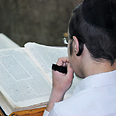
Yeshiva student (archives)
צילום: יואב פרידמן
Between Slabodka and Hebron
Op-ed: Haredim will make every effort to thwart universal draft initiative, preserve Torah world
About 10 years ago I accompanied the head of my yeshiva on a rare tour of towns in Poland and Lithuania, where vibrant Jewish communities existed just a few decades ago – and are no longer; communities that were destroyed in the Holocaust along with all of Eastern Europe's Jews.
One of most poignant moments of that trip was when the head of my yeshiva, Rabbi Haim Serna of blessed memory, asked the rest of the yeshiva heads in the delegation to visit Slabodka, which is in Lithuania. He wanted to see the house in which his wife lived as a child. We arrived at the address, and the mark indicating where the mezuzah was affixed was still visible.
We moved from house to house until we located the structure from which the rabbis were led to their death in the city of Kaunas. When we walked down the street where Lithuania's largest yeshiva - Knesset Yisrael - was located, I phoned my grandmother Rachel Toker, who lives in Jerusalem.
"Grandma, I'm calling you from Slabodka," I said.
I will never forget the excitement in her voice. She chocked back her tears when she heard that her grandson was walking around with his yeshiva head in the town where she was born 95 years ago; where she lost her parents, bother and sisters, who were burned inside the synagogue along with the rest of the members of Slabodka's Kodesh Community.
In order to recreate the far-reaching Torah world that was annihilated in the Holocaust, the main Torah institutions in Israel – the large yeshivas, kolels and Hasidic sects- kept the names they had in Poland and Lithuania. The Panevėžys Yeshiva and the Gur Hasidic sect; the Slabodka Yeshiva and Vizhnitz Hasidic sect; the Valozhyn Yeshiva and Belz Hasidic sect.
My grandfather, Rabbi Yitzhak Toker, was a yeshiva student during the pogroms in the city of Hebron in 1929. On that horrible day in which hundreds of Arab residents of Hebron suddenly attacked the yeshiva and the city's Jews and massacred dozens of them, my grandfather hid in a closet with six other people. They miraculously survived. His brother-in-law, who would later be the chief rabbi of the city of Rehovot, also studied in that yeshiva. He was saved when he lied beneath the body of a friend who was brutally slaughtered by murderers he had met with a day earlier in Hebron.
My father said that in those days it did not seem as though the yeshiva or its students would be revived. But shortly after the survivors buried their friends in a mass grave, they rebuilt the yeshiva – known today as the Hebron Yeshiva in Jerusalem.
My father studied in this yeshiva, as did I. I hope my sons will also study there, because that is the nature of tradition. We educate our children based on this tradition. We believe the Torah must be preserved, in the tradition of Israel, in every generation and every era – generation after generation, without any change, deviation or reform. The Torah remains the same Torah. Always.
When the government decides to draft yeshiva students and lower the number people who study Torah, when it decides on any other measure that can hurt the Torah world, which was rebuilt in the Land of Israel, it must take into consideration that the haredim will make every effort to prevent it. For us, hurting the status of those who study Torah is akin to harming Israel's security, because we believe the Torah protects our nation. Such decisions harm tradition and continuity. They harm what once was.










